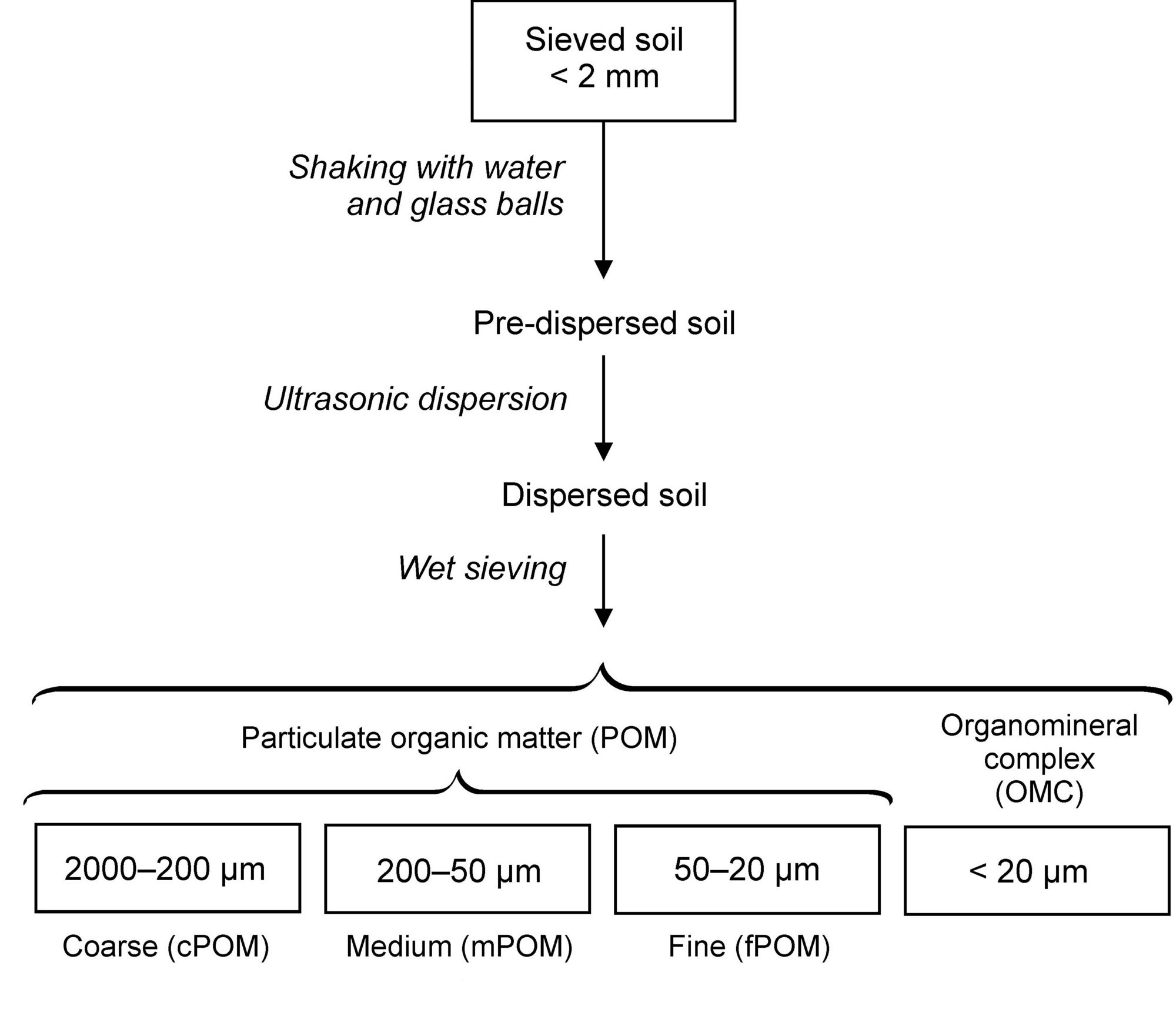Particles Rovira

Method description
Specific hardware needed
- Probe-type ultrasonic disintegrator. Capable of energy releases of 100 W.
- System of stainless steel sieves, of 200, 50 and 20 micrometers hole. A vibratory system is ideal. The system must be able to receive water flush from above, and below the last sieve (that of 20 µm) there must be a stainless steel pan to collect the material passing the last sieve (water + fine silt + clay); this pan must have a lateral mouth, to transfer the collected material to a bottle.
Protocol
a) Pre-dispersion
Put 15 g of the soil sample (air-dried soil, sieved at 2 mm) in a 50 ml Falcon vial (or similar), add two glass marbles and fill the vial to about 3/4 of the volume with deionized water. Seal the vial, and put it in a rotatory agitator, for 1 hour, at low speed: pre-dispersion is most effective if the vial makes a complete turn (i.e. the tube must become inverted at each turn). Energic agitation must be avoided, for it may erode the surface of the vial (which is of plastic material, therefore organic). After this, remove the glass marbles and transfer quantitatively the soil-water suspension to a 100 ml glass beaker. The total volume must be of about 75 ml.
b) Ultrasonic dispersion
Put the beaker (containing the soil-water suspension) within a bath of water containing ice, to avoid an excessive heating of the suspension during sonication. Then, put the sonifier horn within the suspension at a depth of 1.5 cm. Sonicate for 10 minutes at a 100 W energy release. Remove the horn, and recover the small amounts of suspension at the tip.
c) Sieving and recovery of the coarse fractions
The suspension is wet sieved through a column of sieves: 200, 50 and 20 µm hole. Sieving is performed under agitation (mechanic or magnetic) and with a smooth stream of water to help the transfer of material from one sieve to the next. Sieving is finished when the liquid passing through the last sieve has no suspended material. Usually less than 1 liter water is needed, and less than 15 minutes for each sample; but sometimes, in clay-rich soils, longer times and up to 2 liters water are needed.
The material retained in the 200 µm sieve (coarse sand size) often tend to form aggregates as a result of the agitation. It is necessary to smoothly push these aggregates, to disperse them and allow their components (which may be smaller than 200 micrometers) to pass through the sieve.
The materials retained in the sieves are quantitatively transferred to pre-weighed polypropylene vessels, dried at 60ºC and weighed. Three fractions are obtained: 2000-200, 200-50, and 50-20 µm), matching three classical fractions in texture analysis: coarse sand, fine sand, coarse silt. The organic matter of these fractions is considered to be particulate organic matter (POM).
d) Recovery of the fine fraction
To the fraction < 20 µm, collected in 1 L bottles (usually only one), 3 ml of saturated aluminum potassium sulfate solution (AlKSO4, a strong flocculator agent) is added. The suspension is left stand for 2 days in the refrigerator. If flocculation has not been clear, more AlKSO4 may be added.
If the sedimentation has been very clear and the liquid has no signs of suspended material, the part of liquid without suspended material can be removed by siphonation. The bottom of the bottle, containing the flocculated suspension of < 20 µm materials, is transferred to a 250 ml polypropylene centrifuge bottle, and recovered by centrifugation (2500 g, 15 minutes). If the siphonation has not been possible (because the liquid is not clear enough), then it is necessary to centrifuge the whole liquid, in several steps of 200 or 250 ml each. Actually it is better to centrifugate the whole liquid, for this ensures a more exhaustive recovery of the solid materials.
The whole < 20 µm fraction is finally transferred to a pre-weighed vial of 100 ml, dried at 60ºC and weighed. This fraction is taken as the organomineral complex, or the fine silt + clay fraction.
e) Analysis of fractions
All fractions are analyzed by carbon and nitrogen, in an elemental analyzer (ThermoQuest, LECO or similar). If the soil has carbonates, dichromate oxidation methods for analyzing organic carbon may be preferable.
Advantages
- The method gives fractions which are meaningful as to carbon dynamics. We showed in our previous work (Rovira et al. 2010) that the obtained size fractions relate well to the organic carbon lost upon incubation of the soil samples. The larger the proportion of total OC in the < 20 µm fraction, the more stable is the organic matter.
- Even though the method requires skills and a bit of practice (particularly the wet sieving step), when the operator has a bit of experience it is highly repeatable.
Disadvantages
- The water discarded at the end of the process (see step d) contains organic matter, which is not accounted for. On average, 10% of total organic carbon is lost in the process.
- The continuous presence of water during the fractionation may result in the transfer of organic matter between fractions; most particularly, water-soluble compounds may be released from the coarse fractions, and become associated to fine silt or (especially) clays. The ultrasonic treatment enhances this problem; actually, we are working on a version of the protocol aimed to reduce sonication.
References
Lopez-Sangil L. & Rovira P. (2013). Sequential chemical extractions of the mineral-associated soil organic matter: An integrated approach for the fractionation of organo-mineral complexes. Soil Biology & Biochemistry 62, 57-67.
Rovira P., Jorba M., Romanyà J. (2010). Active and passive organic matter fractions in Mediterranean forest soils. Biology and Fertility of Soils 46, 355-369.